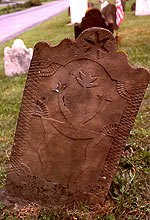 Our April Artist of the month is Leonardo Da Vinci.
Our April Artist of the month is Leonardo Da Vinci.He was born on April 15, 1452 and died on May 2,1519 in a region of Florence, Italy. He was an Italian artist, scientist, engineer, mathematician, inventor, anatomist, painter, sculptor, architect, botanist, musician, and writer. Today he is considered an all-round genius whose paintings and inventions changed the world. Two of his works, the
Mona Lisa and
The Last Supper are his most famous, most reproduced, paintings of all time. Click on either to learn more about each. Click on
10 questions about The Last Supper to learn more about it.
Leonardo Da Vinci is described as a Renaissance Man. This term means a person who is well educated, or who excels, in a wide variety of subjects. The Renaissance was a rebirth or revival of cultural awareness and learning. It took place during the 14th and 15th centuries in Italy, Germany and other European countries. There was a renewed interest in ancient Greek and Roman art and design. The focus was on human beings, the environment, science, and philosophy.
If you want to try a timed two minute puzzle on the Mona Lisa click
here. It took me a couple of times to get it completed on time. Try your skills.
































